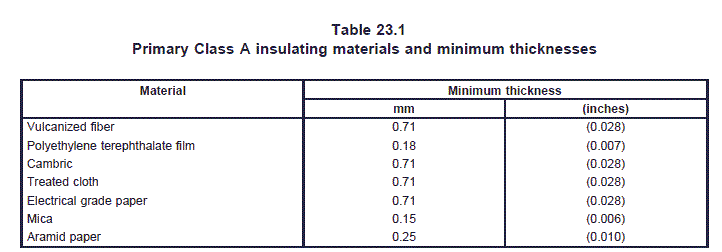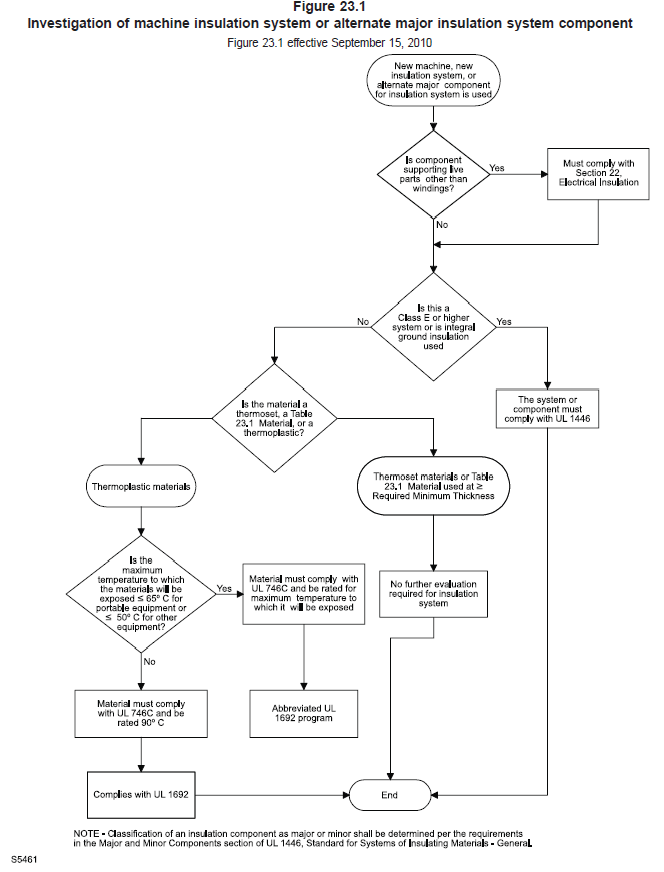
UL1004-1 Rotating Electrical Machines –General Requirements
First Edition – September, 2008
Second Edition -
September 19, 2012
23.1 The insulation system of a machine shall be rated for a temperature not less than that at which the
machine windings are intended to operate in the end-use application under normal conditions. Figure
23.1 for details on investigations of machine insulation systems or alternate major components and
materials.
23.2 Cemented joints used to join two parts of an insulation system so as to provide a contiguous barrier
in lieu of spacings shall comply with the requirements for Adhesives – Specialized Applications, in the
Standard for Polymeric Materials - Use in Electrical Equipment Evaluations, UL 746C.
23.3 The acceptance criteria following the tests specified in 23.2 are:
a) There shall be no obvious separation of the joined parts; and
b) The motor shall successfully complete the Dielectric Voltage-Withstand Test specified in
Section 36.
23.4 The test program specified in this Section for a Class A insulation system shall consider the end-use
of the machine. For instance, a machine for use in attended equipment, products in operation while the
user is present, then the 15-Day Abnormal Operation Test specified in the Standard for Polymeric
Materials – Coil Forms, UL 1692, may not be required. The end product Standard shall be reviewed before
developing a test program for the insulation system.
23.5 Materials in direct contact with uninsulated live parts other than magnet wire shall be a material
specified in 22.1 or comply with the Mechanical/Electrical Property Considerations table in the Standard
for Polymeric Materials – Use in Electrical Equipment Evaluations, UL 746C. Table 22.1 provides the
specific performance levels required.
23.6 All materials used in the insulation system of a machine rated Class E or higher shall comply with
the requirements specified in the Standard for Systems of Insulating Materials – General, UL 1446.
Exception: Polymeric enclosures of thermal motor protectors and/or insulating tubing or sleeving used to
insulate thermal motor protectors which are in contact with motor windings are not required to be part of
the motor insulating system.
23.7 Insulation systems for Class E and higher machines operating at levels where the voltage is 1000
V or more and/or where transient overvoltages are not limited and/or partial discharge is likely to
contribute to the degradation of the insulation system, shall comply with the requirements specified in
IEEE 1776, Recommended Practice for Thermal Evaluation of Unsealed or Sealed Insulation Systems for
AC Electric Machinery Employing Form-Wound Pre-Insulated Stator Coils for Machines Rated 15000 V
and Below.
23.8 Insulation systems for Class E and higher machines employing form wound windings, regardless of
operating voltage, shall comply with the requirements specified in IEEE 1776, Recommended Practice for
Thermal Evaluation of Unsealed or Sealed Insulation Systems for AC Electric Machinery Employing
Form-Wound Pre-Insulated Stator Coils for Machines Rated 15000 V and Below.
Exception: Machines employing form wound windings and operating at 1000 V or less need not comply
with IEEE 1776 when a slot liner is used as the major ground insulation and where the overall insulation
system complies with the Standard for Systems of Insulating Materials – General, UL 1446.
23.9 If materials comprising components of two different insulation systems are to be used within the
same machine, they shall be physically separated by at least 3.18 mm (0.125 inch) of air space.
Exception No. 1: Two different insulation systems may be used, one for the stator and one for the rotor,
of a universal motor and they need not be separated by the minimum distance of 3.18 mm (0.125 inch).
Exception No. 2: This requirement does not apply to motors rated Class A.
23.10 All insulation systems employing integral ground insulation shall comply with the requirements
specified in the Standard for Systems of Insulating Materials – General, UL 1446.
23.11 Class A insulation systems shall consist of a combination of magnet wire and major component
insulation materials evaluated and found to operate as intended for this use. Thermoset materials and
materials in Table 23.1 at the thicknesses specified are permitted to be used without further evaluation.
Wood is permitted to be used for wedges. Other materials shall comply with 23.12.

23.12 For Class A insulation systems employing other materials or thinner materials than those indicated
in Table 23.1 or a combination of materials, the materials, whether polymeric or not polymeric (treated
cloth, for example), shall comply with the requirements specified in the Standard for Polymeric Materials
– Coil Forms, UL 1692. When reviewing Figure 23.1 for tests related to the use of insulating materials in
insulating systems of UL 1692, the end-use of the machine shall be considered as indicated in 23.4. Any
of the possible tests in UL 1692 may be eliminated or adapted to meet a specific end-use application. The
Locked Rotor Cycling Test described in 42.2.2 may be performed in lieu of the Abnormal Conditioning
Test of 7.4, Severe Conditioning Test of 7.5, Overload Burnout Conditioning Test of 7.6, and the 15-Day
Abnormal Operation Test of 7.7, in UL 1692.
Exception: The combination of the Locked Rotor Temperature Test and Locked Rotor Endurance Tests
described in Section 41A, Locked-Rotor or No-Load Temperature Test, and Section 41B, Endurance Test,
of the Standard for Impedance Protected Motors, UL 1004-2, and Section 41A, Locked Rotor Temperature
Test, and Section 41B, Locked Rotor Endurance Test, of the Standard for Thermally Protected Motors,
UL 1004-3, may be substituted for the Locked Rotor Cycling Test.
23.13 Machines provided with oil as a cooling or insulating medium shall be subjected to the Oil
Compatibility Test, Section 40, to ensure that incompatibility of the oil with the remaining insulation system
materials does not result in unacceptable deterioration of insulating properties.
23.14 The oil used in machines that make use of oil as a cooling or insulating medium shall have a flash
point no lower than 95°C (203°F) higher than the temperature rating of the insulation class, (for example,
200°C for a Class A motor).
Exception: A thermally protected motor evaluated to the requirements of the Standard for Impedance
Protected Motors, UL 1004-2, or the Standard for Thermally Protected Motors, UL 1004-3, may use an oil
with a flash point no lower than 20°C (36°F) higher than the highest temperature recorded during the
Locked Rotor Tests.
